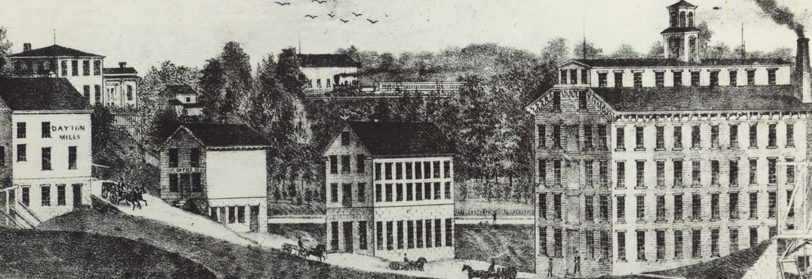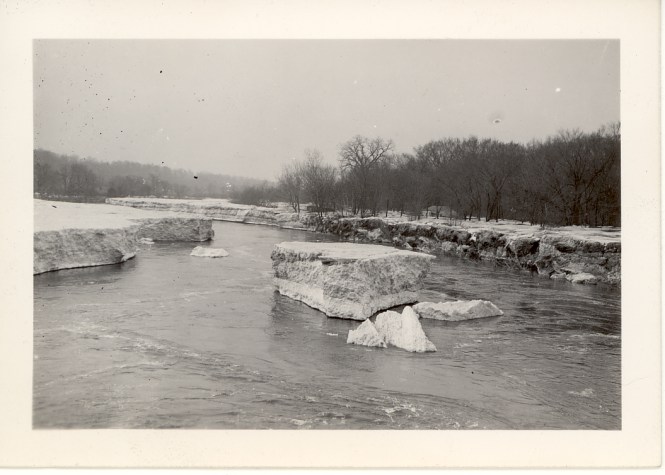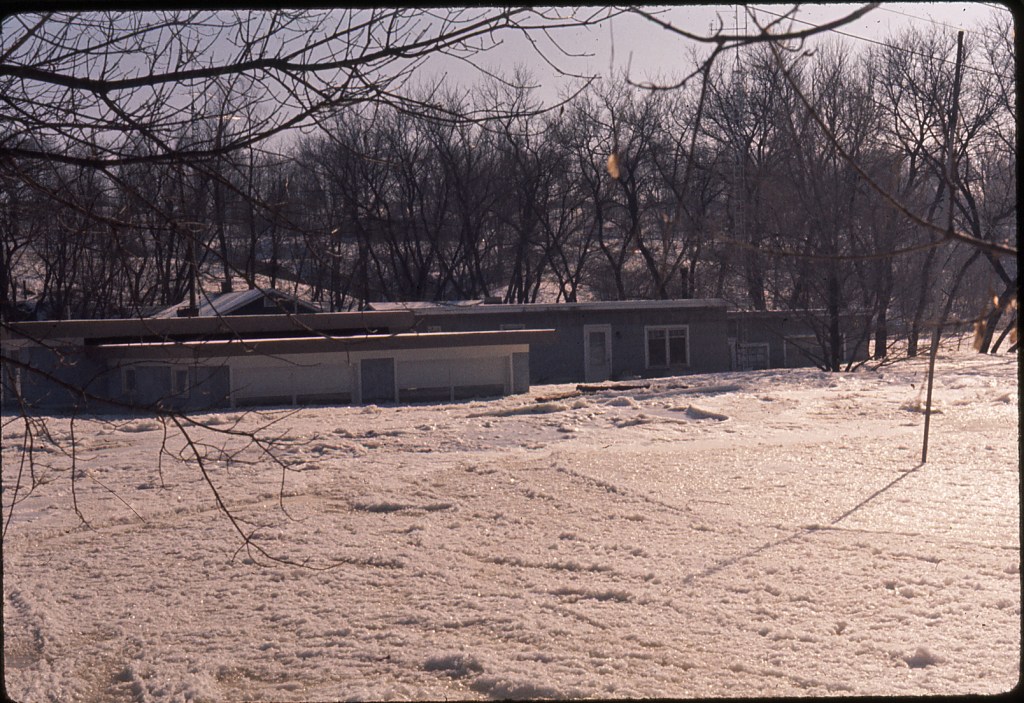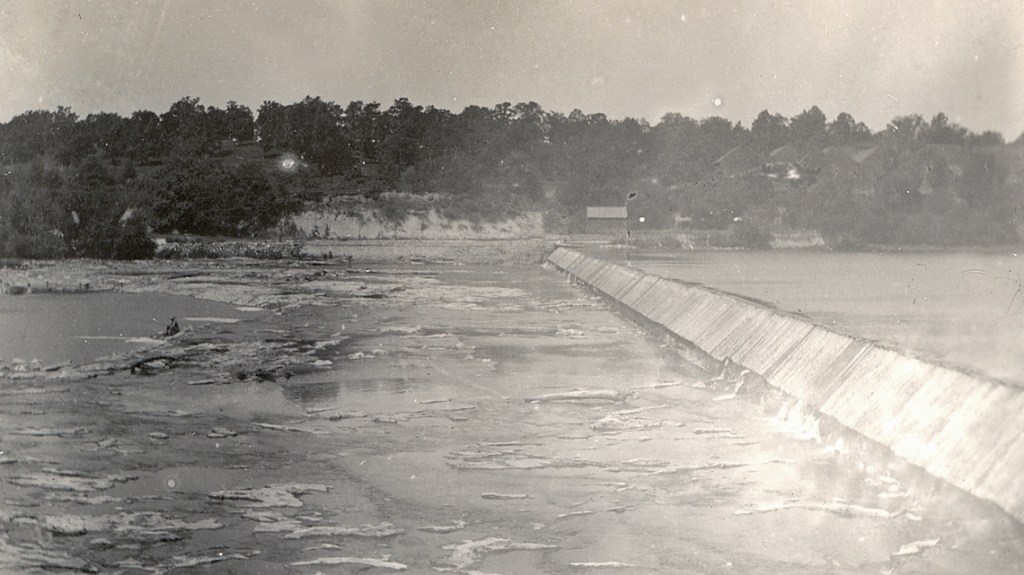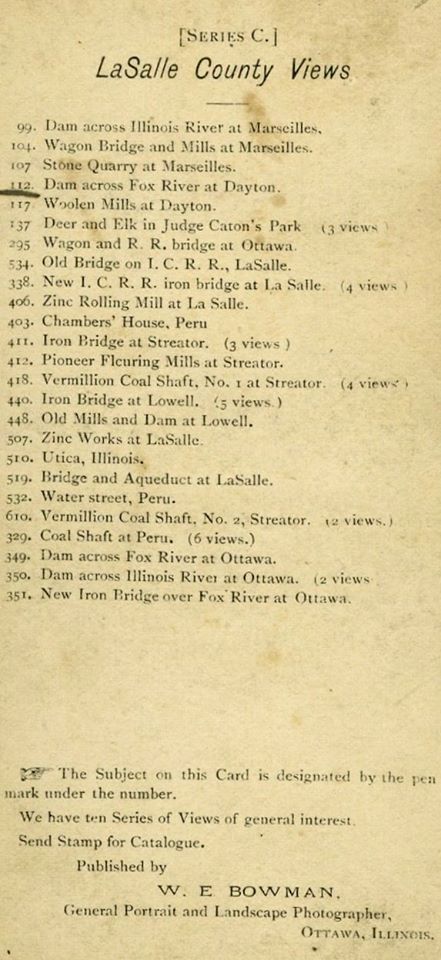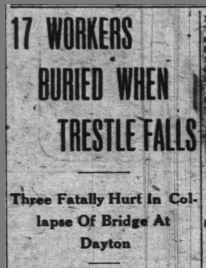
Not the 1887 event, but the river was never tame in the winter.
The Ottawa [Illinois] Free Trader, February 12, 1887, p. 4, col. 6
From Dayton
Dayton, Ill., Feb. 11th, 1887. – The little Fox became the raging Ohio during the flood of last Tuesday. Never since 1857 have we had such a heavy run of water and ice. The ice commenced running Tuesday morning, and run two hours; just before noon it run two hours, and in the evening it run five hours, making nine hours, run. And contrary to the usual manner, the last ice running, instead of being the lightest, was the heaviest, some of it being two feet thick. The fish chute was carried out, but no damage was done to the dam. One of the gates at the locks was broken, and the feeder bank was washed nearly through for quite a distance. The water was so high it ran over the locks and the surrounding embankment. The trestle work of the second span of the new bridge was carried away Monday night, and during the heavy run of ice Tuesday evening, the stone were all knocked out of the noses of the piers, leaving them in a very battered condition. The water alongside of the piers was nearly twenty feet deep. The paper mill lost six hundred dollars worth of straw, which is quite a loss to them, as it is difficult to replace it at this time of year, on account of the bad roads.
The Ottawa [Illinois] Free Trader, February 19, 1887, p. 1, col. 4
Please Rise and Explain
The managers of canal affairs in this city have provoked the ire of divers and sundry of our manufacturers here, by either gross inattention to their duties or a want of due knowledge thereof, as follows:
On Sunday last an ice gorge occurred in the river and feeder of the canal at Dayton, and soon the waters there were on a level – formed a “pool,” and threatened to do considerable damage. On Sunday evening the ice broke away and the waters subsided. Then the waters in the canal were let out, why, no one knows, as all danger was then over. The canal remained dry four days, during which every manufactory in Ottawa whose power is supplied by water was idle. The canal and feeder banks were all sound and no repairs were needed, and none have been made. This withdrawing of the water and stopping the factories, as figured by the proprietors of the different establishments, resulted in damage as follows:
Victor and City Mills, per day, $70; H. C. Strawn, $10; Tile Works, $250; Weis & Wolf, $10; King, $10; Koeppler, $15; Colwell and Rugg, and the Electric Light Co., not reported. Result, a loss of $865 a day, or $1,460, to the factories that have been heard from.
The State of Illinois or its servants ought to make good this loss, in the absence of a satisfactory explanation.
The Ottawa [Illinois] Free Trader, February 26, 1887, p. 8, cols. 2-3
From Dayton
Dayton, Feb. 24. – The slush ice is slowly cutting away out of the river, but large banks of it twelve feet thick remain upon the shores. The mills all got started up again this week.
Your valuable paper last week, in an article under the heading of “Please Rise and Explain,” publishes some things in regard to the shutting out of water from the feeder and canal, which your reporter obtained from a very unreliable source, for there is hardly a word of truth in the whole article. Our manufacturers and citizens who witnessed the flood of the 18th all agree in saying that the canal authorities acted wisely in closing down the gates and thus preventing much greater damage than was actually done; and it is but just to those in authority to state the true facts. Your article stated that “on Sunday evening the ice broke away and the waters subsided.” Now, this is not true, for although the waters subsided a few feet, yet the ice did not break away, but, on the contrary, the ice remained in the same dangerous condition as it was on Sunday, and a fall of temperature, bringing down more slush ice on Monday, would have made the situation more dangerous than on Sunday. Your article further states, “Then the waters in the canal were let out, why, no one knows, as all danger was then over.” As a matter of fact, the water in the feeder and canal was let out about nine o’clock Sunday morning, and a messenger on horseback was dispatched to the canal authorities warning them of the danger to the banks. A gang of the state’s men watched the feeder banks all night Sunday ready to cut it and let the water back into the river again should the danger increase. Again we quote “The canal remained dry four days, during which every manufactory in Ottawa whose power is supplied by water was idle.” Sunday, when the current of the river was forced by the slush ice into the feeder, an ice jam was formed which completely shut off all the water and forced it over the banks into the river again. Tuesday morning, when it was thought the danger was over for the present, the lock gates were raised, and as much water was let in as could be forced through the ice jam. It required two or three days to cut out the ice, and the feeder and canal were being filled as rapidly as possible. If the gates had been left up during the flood there is no question but that a large amount of the bank would have been washed out, which would have taken at least two weeks to repair. Then, let us figure what the damage would have been to the Ottawa manufacturers had the canal authorities not taken the precautions they did: Victor and City Mills, $70 per day, 12 days, $840; H. C. Strawn, $10 per day, for two weeks, $120; Tile Works, $250 per day, for two weeks, $3,000; Weiss & Wolf, $10 per day, for two weeks, $120; King, $10 per day, for 12 days, $120; Koeppler, $15 per day, for 12 days, $180. Result, an actual loss of $1,460 – a probable loss of $4,380, leaving to the credit of the canal authorities $2,920 by reason of their taking such precautions as they did.
Occasional
The Ottawa [Illinois] Free Trader, March 5, 1887, p. 4, cols. 5-6
The Freshet and the Canal
Ottawa, Ill., March 3, 1887
Messrs. Editors: – As “Occasional” has charged in your issue of Feb 26th that the statements made in your issue of Feb. 19th were nearly every word false; and as those statements were obtained from me, in an interview with your reporter, I feel that I ought to reply briefly to the wholesale charge of falsehood.
I visited Dayton Tuesday, Wednesday and Thursday following the overflow of the canal bank at Dayton, on Sunday, the 13th of February last. I examined and inspected the canal banks, lock and floodgates each day; and I hereby declare and affirm that not a cent’s worth of damage was done to the canal banks or canal property at Dayton at that overflow, either Sunday, Monday, Tuesday, Wednesday, or Thursday, the day they finally let in the water. Nor was there one cent’s worth of work done nor material furnished or used for any repairs to the canal during that time at that place for any damage done the canal by the overflow of the Fox river into the canal.
The canal authorities declared to me Tuesday morning, standing on the bridge at Dayton, that there was no damage done to the canal.
Now, will Mr. “Occasional” inform me, or the public, why the water could not have been let into the canal as soon, at least, as its authorities were informed that no damage was done, and that no repairs were needed.
“Occasional” says that some water was let in on Tuesday. That may be true; but I measured the water in the lock at the head of the feeder every day, – Tuesday, Wednesday and Thursday, – and the water was twenty inches lower Thursday morning than Wednesday morning; so that if the gates were opened Tuesday, they must have been closed again.
“Occasional” says that the State men watched the banks all night Sunday night, and at the same time admits that the ice gorge broke below the dam, in the river, Sunday night and that the water went down. But he neglects to inform us that on Monday (notwithstanding, as he says, the danger was over) they did cut the feeder bank more than one mile below where the overflow was and when there was no water in the canal and no prospect of any. And this large hole was cut in the narrowest part of the bank and where, if a washout could have been furnished to the invitation thus made and kept open three full days (for it was not refilled until Thursday, I think it would have been later than the next planting time before the bank would have been rebuilt. “occasional,” especially in the Ottawa Republican, is very full in his charge of falsehood, but still follows each charge with an admission of facts stated in the Free Trader of the 19th of February. He says, if the weather should change, &c., &c.; as well he might say, if we should have a June freshet, or if some other awful thing should happen, it was safe to wait and see.
The canal authority that would shut the water out of the canal and keep it out for four days and cut a large hole in the canal bank and keep it open three days as a precaution against what may happen in the future, is no doubt a very prudent authority.
And now, if “Occasional” will point out, over his own signature, where one cent’s worth of damage was done to the canal on account of the overflow, or where, during the time between Sunday and Thursday, one cent’s worth of repairs was made by the canal authorities on account of the damage done by the overflow, that shall be the truth, then I will confess that I am wrong. Until that is done, no matter how many times you charge me with falsehood, the facts as stated must stand for the truth.
No, Mr. “Occasional,” the conduct up there at that time is consistent with the conduct here daily. There is hardly a day but the water in the main canal is anywhere from ten to twenty inches below navigation stage. That, Mr. Authority knows full well, taken from a six-foot head, well nigh destroys the power on that head. And all, as Mr. Authority says, because he will take no chances.
Once more, if, as “Occasional” says, it was true that an ice bar was formed across the feeder below the gates so that no water could pass if the gates were open, then, in the name of common sense, why were the State men set at work Monday cutting the canal bank one mile down the feeder, where there was no water and none could be got if his statement was true? There is an adage, that “of all men, liars ought to have good memories,” – or ought to have reason enough to see where their statements convict themselves.
Respectfully, Wm. Thomas
The Ottawa [Illinois] Free Trader, March 12 [printed; actually 19], 1887, p. 2, col. 5
The Dayton Flood Again
Dayton, March 3, 1887 – On your last issue Mr. William Thomas, an old citizen of Ottawa, came out in a lengthy article admitting that he is the author of the unjust criticisms on the action of the canal authorities, and charging your correspondent with telling falsehoods. Our citizens and manufacturers feel that Mr. Thomas has very much misrepresented the facts in this matter and desire that we should answer his article and place the facts again correctly before the public.
Why should we write anything but the truth when we are a user of the water at this place and a loser by the shutting out of the water? We are also your reporter for this vicinity and always try to give your paper nothing but the facts, and we know that we are supported by the citizens here who were eye-witnesses of the overflow, in saying that we have given the facts correctly in the matter.
In Mr. Thomas’ whole article he does not (and cannot) deny the points we made, viz.: of the danger during Sunday and Monday, Feb. 13th and 14th of a wholesale destruction of the banks, and of the fact that the canal was filled as rapidly as the water could force its way through the ice jam. There can be no denial of these facts.
Mr. Thomas charges that we admitted that the ice gorge broke below the dam Sunday night. Why does he say this, when in our last correspondence dated Feb. 24th, this was one of the points which we most emphatically denied. We claimed that the ice remained in the same dangerous condition on Monday as on Sunday.
Mr. Thomas claims that on Tuesday morning the canal authorities declared to him, standing on the bridge at Dayton, that no damage was done to the canal. We were present during that conversation, as were also three or four more responsible witnesses who testify to the same thing, and heard the canal supt. say that he did not know what damage was done to the banks. How could he tell when the ice was piled up all over the banks? Mr. Thomas acknowledged during the conversation on the bridge, that he had been up trying to examine the banks but as he had no shovel to clear away the ice, he could not tell the condition of the banks.
In regard to the big hole in the bank, he states was cut on Monday. These are the facts: the canal authorities thought the danger so great that they employed the bridgemen who were idle that day to cut the frost out of the bank below the paper mill, so that in case the river raised again and overflowed the banks, the bank could be quickly and easily cut and the water turned into the river again, and the canal would not be given more water than it could dispose of. It was not safe to cut the bank any nearer the locks as the river was too high.
We have never said or claimed that any damage was done to the banks at this time, but these are the facts: during the heavy run of ice of Feb. 8th the banks near the dam were cut about one-half through for a distance of nearly 100 feet, and the states’ men were two or three days repairing them, but the banks were still weak, however, when the flood of the 13th came on and it was only by a narrow escape that they were preserved. Instead of finding fault, Mr. Thomas should feel thankful that his electric light was not dimmed for three months instead of three days.
In regard to the measurements which he states he made at the lock, we have responsible witnesses who testify that at no time was the water more than fourteen inches low at the locks and that more water was being let in every day than could force its way through the ice jam.
We have interviewed a few of our prominent citizens and give you their opinions: A. F. Dunavan, Esq., of the Horse Collar Works, says he feels confident that the authorities did the proper thing in shutting out the water on that Sunday, and that there was great danger to the banks by the overflow. His factory was laid idle for a few days, but he feels confident that his loss would have been much greater had not the canal authorities shut out the water. J. W. Channel, of the Tile Works, says he is positive the authorities did perfectly right in shutting out the water, and that any one who would have seen the condition of the river at the dam at that time could not have a different opinion. He was an eye witness of the overflow. He had lived in Dayton a good many years, and never saw the water in as dangerous a condition to the banks as on that Sunday and Monday.
O. W. Trumbo who has lived here 30 years says he never saw the water so high. Mr. D. Moore of the paper mill thinks the authorities did the proper thing, as do Mr. Davis and Green Bros.
Occasional
————————————- AND THAT’S THAT, SO THERE!!
